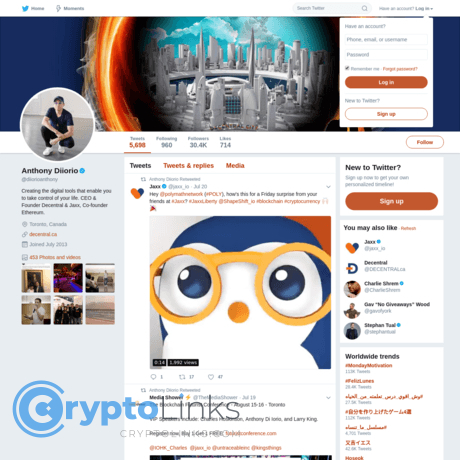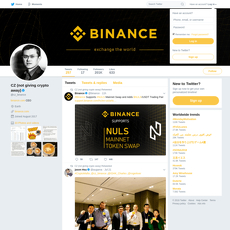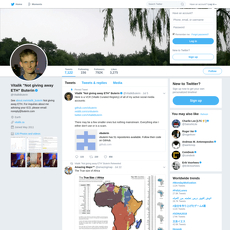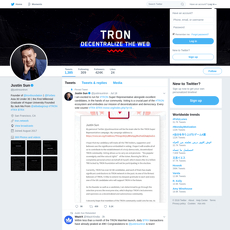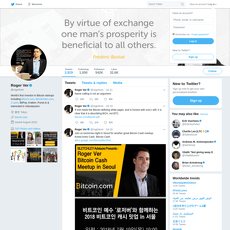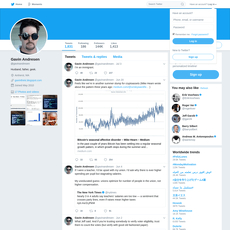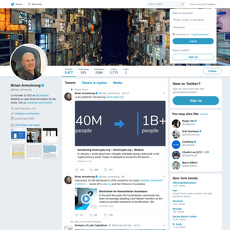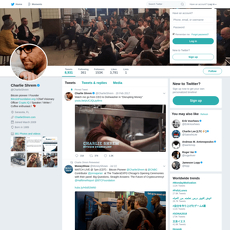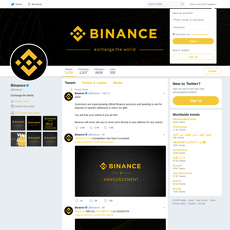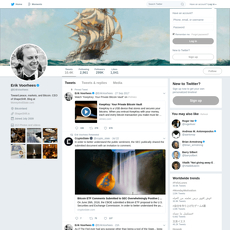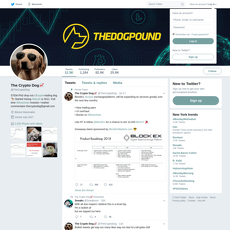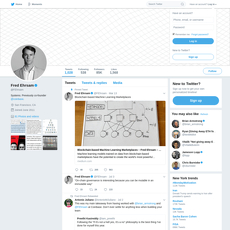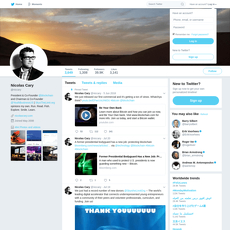Anthony Diiorio Review
Anthony Diiorio
twitter.com
Anthony Di Iorio review guide: everything you need to know + FAQ
Wondering who Anthony Di Iorio really is, why his opinions still carry weight, and whether following his X/Twitter is worth it?
If you’ve ever tried to piece together his story from random threads, old headlines, and hype posts, you know it gets messy fast. This guide clears that up so you can decide—quickly—if his work and his feed fit your interests.
Where most people get stuck
There’s just enough misinformation and dated content about Di Iorio to waste your time. A few common traps:
- Outdated net worth numbers: People keep quoting the same 2018 estimate (Forbes pegged him at $750M–$1B back then—see Forbes, Feb 2018). Markets change, private holdings shift, and context matters.
- Confusion about Ethereum involvement: Is he still part of the Ethereum Foundation? Is he active in governance? Many posts blur “co-founder” with “still running things,” which isn’t how it works.
- What he’s building now: You’ll see mentions of Andiami without a clear explanation of what it aims to solve or how it fits into decentralization.
- Signal vs. noise on social: If you’re expecting price calls or memes, you might miss why his feed is useful—he focuses on infrastructure, incentives, and practical decentralization.
Quick research tip: Studies on web behavior show readers scan for clear “information scent” and prefer skimmable structure over walls of text. That’s why this guide is tight and easy to navigate. For example, see Nielsen Norman Group’s take on scanning and clarity:
Information Scent.
What you’ll get here (no fluff)
I’ll cut through the noise with a clean timeline, what he’s actually known for, what he’s working on today, and what to expect from his social presence. You’ll leave with straight answers, trusted links, and a clear sense of whether following him helps your research.
- Simple timeline: From early Bitcoin enthusiasm to Ethereum co-founding to product building.
- What he’s known for: Organizing, funding, and building tools people actually use.
- Current projects: Where his energy is going now and why it still matters.
- Social presence breakdown: What his posts focus on, how often, and who will benefit.
- Speedy FAQ: Answers to the questions everyone asks, with context.
What this guide covers (and how it helps you)
- Who he is and why he matters: The concise bio you actually need.
- Key milestones: Toronto Bitcoin meetups, co-founding Ethereum, building Decentral/Jaxx Liberty, launching Andiami.
- How he uses X/Twitter: What you’ll learn from following @diiorioanthony, with real examples of the kind of posts he makes.
- Net worth context: Why headline numbers can mislead—and what to focus on instead.
- Research shortcuts: Where to find credible info fast so you don’t waste weekends on rabbit holes.
Ready for the quick, no-nonsense bio and why his background actually matters today? Up next, I’ll walk through the key moments—from the Toronto Bitcoin meetups to co-founding Ethereum—that set the stage for everything else. Want the 30-second version first or the full story?
Who is Anthony Di Iorio? A quick bio and why he matters
Anthony Di Iorio is one of those rare builders who helped set crypto’s early rails and then kept pushing for products people actually use. He co-founded Ethereum in 2013, championed Bitcoin before it was cool in Canada, launched the product studio Decentral, shipped the multicoin non-custodial wallet Jaxx Liberty, and even served as the first Chief Digital Officer at the Toronto Stock Exchange. His thread through all of this: practical decentralization. Not the bumper-sticker kind—real tools, real users, real tradeoffs.
“Decentralization only matters when it touches real people.”
That mindset shows up in how he organizes communities, backs research, and builds hardware and software aimed at reducing choke points. If you follow his work, you’ll notice a consistent belief: user control beats hype, and infrastructure is where durable wins are made.
From Bitcoin meetups to Ethereum
In 2012, he started hosting Bitcoin meetups in Toronto—simple gatherings that became a magnet for curious developers, economists, and entrepreneurs. Those rooms birthed conversations that led to introductions, including meeting a young Vitalik Buterin who would share an early version of the Ethereum whitepaper. Di Iorio backed the vision and became one of Ethereum’s eight co-founders, helping fund and organize early efforts that turned a compelling paper into a live network.
It sounds small—a meetup—but that’s the point. Communities move technology, and he has a knack for creating spaces where the right people collide. If you’ve ever found your next big idea at a local meetup, you know the energy. You can still see that community-first posture in his updates on @diiorioanthony.
Decentral and Jaxx Liberty
By 2014, he founded Decentral, a product studio focused on giving people control without forcing them to be experts. The team’s most recognized product, Jaxx (now Jaxx Liberty), became a go-to non-custodial wallet during the 2016–2018 surge. What made it stand out back then?
- Multi-asset support early on: One interface for BTC, ETH, and a range of assets when that was still rare.
- Cross-platform simplicity: Mobile, desktop, and browser extension with a familiar UI.
- User-controlled keys: Non-custodial by default—no account creation or email required.
- Quality-of-life features: Integrated token management and in-app swap services at a time when hopping between tools was the norm.
Why does that matter? Usability is still one of crypto’s biggest friction points. Independent UX research from Nielsen Norman Group has repeatedly found that complexity, unclear mental models, and fear of irreversible mistakes keep mainstream users away. That’s the exact pain Jaxx tried to reduce with “it just works” design for non-custodial wallets. If you’re curious, NN/g’s take on crypto UX problems is a worthwhile read: nngroup.com/articles/cryptocurrency-ux/.
Was it perfect? No wallet is. But the intent is the story: make self-custody accessible without gatekeepers. That’s the kind of product thinking Di Iorio keeps gravitating toward.
TSX role and broader profile
He wasn’t only building in crypto-native circles. He crossed into traditional finance as the first Chief Digital Officer of the Toronto Stock Exchange (TMX Group), an unusual move at the time that signaled a serious, strategic conversation between institutions and decentralized tech. That role built bridges—getting regulators, enterprises, and startups talking the same language about security, data integrity, and transactional rails. It gave him a seat at the table where policy, risk, and innovation meet, and it’s one reason he still draws attention from both worlds.
Andiami (launched 2022)
More recently, he launched Andiami, a project with a bold, almost old-school ethos: fix the difficult stuff people ignore. The aim is to reduce centralization pressure points in decentralized networks by combining:
- Hardware: User-friendly gear to run and maintain critical network services, so we don’t rely on a few big data centers.
- Incentives and game theory: Encourage participation where networks need it most (think: nodes, indexing, and data availability).
- Education and community: A “quest” structure that rewards learning and contribution, not just speculation.
If you’ve ever worried about how many nodes sit on the same cloud providers, you’ll get why this matters. Andiami fits his pattern: align people, incentives, and tools so decentralization survives real-world constraints.
So where does this builder’s track record leave his connection to Ethereum today—hands-on, hands-off, or something in between? Let’s clear that up next...
Is Anthony Di Iorio still involved with Ethereum?
Short answer: not in any formal or day-to-day role with the Ethereum Foundation, and not in protocol governance. He’s still very much supportive of the ecosystem, but he channels his time into independent initiatives that push decentralization and user control—think infrastructure, hardware, incentives, and education rather than protocol politics.
“Chase the systems that reduce single points of failure, not the next pump.”
Early role vs. current stance
He helped co-found Ethereum in 2013 and funded early efforts that got the project off the ground. As the network matured, he stepped back from formal roles, choosing to build in parallel. That independent streak shows up in how he operates today:
- He speaks at major industry events and joins long-form conversations about decentralization, incentives, and security, rather than internal EF debates.
- He works on projects like Andiami (launched in 2022), which aims to make networks more resilient through a mix of hardware and game-theory design—complementary to Ethereum, but not tied to its governance.
- He collaborates selectively across ecosystems and companies when it moves the ball forward for real users.
If you’re looking for protocol EIPs or EF meeting notes from him, you won’t find them. If you want frameworks and tooling that help people actually run and control their own infrastructure, that’s his lane.
How he frames ETH vs. BTC
He’s been clear for years: Ethereum wasn’t built to be a rival to Bitcoin, it was built to try a different approach.
- Bitcoin: sound money, settlement, and a conservative security model.
- Ethereum: general-purpose programmability for apps, coordination, and complex incentives.
That’s why you’ll see him reference both in the same breath. He respects Bitcoin’s role and sees Ethereum as tackling different problems. If you’re tired of tribal takes, his stance feels like a breath of fresh air—especially for builders who straddle both worlds.
There’s good reason to care about this framing. Research has repeatedly shown that decentralization is nuanced and multi-dimensional. For example, a widely cited measurement study from Cornell/IC3 researchers found different decentralization properties across Bitcoin and Ethereum nodes and miners (Quantifying Decentralization in Bitcoin and Ethereum, 2018). Client diversity and node distribution—things he cares about—are measurable and matter for security. You can see current client share snapshots at Ethernodes, which regularly highlights why over-reliance on any single client increases risk.
What this means for followers
If you follow @diiorioanthony, expect practical, ecosystem-wide thinking instead of protocol power plays:
- Pragmatic decentralization: threads on removing centralization vectors (nodes, clients, hosting, RPCs), not just slogans.
- Infrastructure and usability: hardware and tooling that help people run their own stuff—because decentralization doesn’t count if users can’t actually use it.
- Security-first mindset: consistent reminders to control keys, limit trust, and reduce attack surfaces.
- Cross-ecosystem respect: thoughtful takes on where Bitcoin and Ethereum each shine, with zero tribal bait.
- Event and project updates: talks, interviews, and independent initiatives that aim to strengthen the broader crypto stack.
It’s less “ETH vs. BTC” drama and more “How do we build systems people can rely on for decades?” If that’s your wavelength, his feed is signal. And if you’re wondering how this independent approach translated into business outcomes—and what the headlines got right or wrong about his wealth—want to see the real story behind those numbers next?
Net worth, business wins, and the reality behind the numbers
Forbes estimated Anthony Di Iorio’s wealth at $750M–$1B back in February 2018. That was peak mania season for headlines, and crypto has lived three lifetimes since. Prices swing, private stakes reprice, and some of the most valuable bets in this space are either illiquid or deliberately off the grid. Treat any “current net worth” you see as a snapshot, not a verdict.
I look at the arc, not just the number. The arc explains how someone gets there and—more importantly—how they keep it.
“Numbers tell the story of what you earned. Security decides whether you get to keep it.”
Where the wealth likely came from
There’s no mystery playbook here—it’s conviction, building, and positioning. Based on public history and industry patterns, here’s what likely powered the bulk of his wealth:
- Early Bitcoin and Ethereum exposure: He organized Bitcoin meetups in 2012 and co-founded Ethereum in 2013. Early conviction plus meaningful allocation or early purchases are exactly how asymmetric outcomes happen in crypto. Example: Early participants who held through the 2017 and 2020–2021 cycles saw life-changing multiples without trading every wiggle.
- Founding stakes and ecosystem equity: Founders often receive allocations or early access that compound dramatically if the network succeeds. Ethereum’s growth turned early belief into outsized upside for anyone who held.
- Product value via Decentral and Jaxx Liberty: Building a popular non-custodial wallet during the 2016–2018 onboarding wave didn’t just create direct business value—it built reputation, distribution, and deal flow. Those are assets that keep paying off.
- Angel investing and advisory: When you sit at the intersection of BTC and ETH communities with a builder’s background, you see high-quality opportunities early. Select angel checks, advisory roles, and strategic stakes can outperform even during messy markets.
Quick reality check: In crypto, “wealth” is a moving target. Holdings can be a mix of liquid coins, locked tokens, private equity, and IP. Media headlines often miss vesting schedules, tax events, hedges, and the fact that many builders purposely cap public exposure.
Security and personal risk lens
If you’ve followed his story, you’ve seen a consistent theme: wealth is only real if you can secure it. He’s been unusually open about safety concerns and risk management shaping his decisions—right down to limiting how public he is and which projects he takes on. In 2021, major outlets reported he was stepping back from frontline crypto roles to reduce personal risk (Reuters).
The caution isn’t paranoia—it’s pattern recognition. A few data points worth knowing:
- Social engineering is the #1 attacker tool:Chainalysis’ annual crime reporting shows that scams, phishing, and human-factor exploits consistently top the list of crypto losses (Chainalysis Crypto Crime Report).
- SIM swaps are still rampant: The U.S. FCC has issued consumer advisories on SIM-swapping because it routinely leads to wallet drain via stolen 2FA and password resets (FCC advisory).
- Investment scams cost billions yearly: The FBI’s IC3 reports continue to show multi-billion-dollar losses tied to investment fraud with a crypto component (FBI IC3 2023).
What does that mean in practice? If you’re visible, you’re a target. If you’re wealthy, you’re a bigger target. If your wealth is portable and pseudonymous, the rules change again. He seems to operate with that mental model, and it’s a useful one for anyone building long-term in this space.
Actionable habits I’ve seen serious builders adopt—and the kind of playbook his public stance hints at:
- Multi-layered custody: Hardware wallets, multisig, and compartmentalized accounts for different risk buckets.
- Anti-social-engineering discipline: No screenshots of balances, no casual location tagging, strict phone and email hygiene, and recovery kits stored offline.
- Operational separation: Personal vs. business assets, travel devices vs. home devices, and strict vendor vetting.
- People security: Fewer people with access, better training for those who do, and a standing incident plan.
The big idea: wealth and security are the same project. He treats them that way—and that’s probably why his story is still compounding.
Takeaway for readers
Don’t obsess over a fluctuating headline number from 2018. Focus on the repeatable edges:
- Conviction early, patience later: Own assets you understand and can hold through noise.
- Build useful things: Distribution and reputation create deal flow you can’t buy.
- Security-first, always: Protect what you build before you try to build more.
- Optionality over hype: Keep independence so you can pick your shots in any market.
If you’re wondering how this mindset shows up in his day-to-day posts—what exactly he publishes, how often, and whether it’s signal or noise—want a quick, honest tour of his X/Twitter before you hit follow?
Reviewing @diiorioanthony on X/Twitter: what you’ll actually get
Open Anthony Di Iorio’s X/Twitter and you won’t get a dopamine drip of price calls. You’ll get thoughtful threads about how real decentralization works in practice, updates on Andiami, and practical product ideas that make crypto less fragile and more usable.
He posts less often than the average “crypto personality,” but when he does, it’s usually signal. Expect notes on infrastructure, governance trade-offs, and how to remove single points of failure—paired with community-oriented calls for builders to test, run, and share.
“Don’t trust. Verify.” — the ethos you’ll see reflected across his feed: less noise, more first-principles thinking.
Signal you can expect
Here’s the texture of his posts, based on what I routinely see in his timeline:
- Measured threads, not hot takes: He’ll unpack why something matters—client diversity, validator distribution, service provider concentration—rather than farming engagement.
- Decentralization checklists: Expect posts that nudge builders to ask: Who can turn this off? What’s the failover? Where are the choke points? These are practical prompts you can take back to your product or research.
- Andiami updates that double as education: Hardware snapshots, network coordination notes, and token-incentive thinking presented as “here’s how to reduce centralization pressure” rather than “wen moon.”
- Usability and self-custody design: He frequently highlights the need for tools that real people can operate safely—echoing long-standing UX research that simpler, consistent flows reduce error rates and abandonment. If you’ve seen the Nielsen Norman Group’s findings on reducing cognitive load, you’ll recognize the same principles in what he boosts.
- Cross-ecosystem respect: Posts that treat Bitcoin and Ethereum as distinct tools serving different goals, with an eye toward interoperability and user empowerment instead of tribal shouting.
- Safety mindset: Reminders on threat models, OPSEC, and vendor risk—useful if you’ve read the MIT paper showing sensational content spreads faster than facts on social platforms (Vosoughi et al., Science). His feed pushes in the opposite direction: slow down, verify, secure.
Recent examples of the pattern you’ll notice:
- A thread connecting home node hardware to network resilience, with a call for more diverse node operators—not just cloud heavyweights.
- Event takeaways summarizing coordination problems (governance, funding models, client split) and offering frameworks teams can actually apply.
- Short posts spotlighting tools that reduce reliance on single providers—from key management to data transport—often paired with questions that nudge debate rather than end it.
Who should follow him
- Builders and product leads: If you’re shipping wallets, nodes, or infra, the “how do we remove choke points?” lens will sharpen your roadmap.
- Researchers and policy folks: You’ll get clean problem statements around centralization vectors and incentives—great jumping-off points for papers or proposals.
- Investors with a long horizon: Useful for filtering hype. Posts help you gauge which teams are building things that last versus things that trend.
I like following him alongside a few protocol devs and security researchers; the contrast makes it easier to spot survivable designs versus buzz.
Possible drawbacks
- Not a trading feed: If you want daily entries/exits, this isn’t it.
- Lower frequency: Weeks can pass between deep posts. Quality over quantity.
- Principle-first: He’ll sometimes ask hard questions about decentralization that don’t resolve in a single thread. If you want quick certainty, you might feel impatient.
That said, there’s a good reason to prefer this pacing. Research on information reliability shows slow, contextual content tends to be more accurate and useful over time (see Pew’s work on news on social platforms). His posting style leans into that.
Notable appearances and content
- Conference clips and frameworks: Watch for Consensus-style talks and Canadian events where he lays out system maps: where power accumulates, how incentives reshape networks, and what builders can do about it.
- Long-form interviews: He shines when there’s time to unpack design trade-offs—expect thoughtful back-and-forth on nodes, hardware, and governance rather than soundbites.
- Project roadmaps: Andiami updates often include community coordination pieces—waitlists, hardware news, and calls for testers—that make it easy to get involved without buying the hype.
If you’ve ever felt overwhelmed by loud feeds and short-term noise, his account is a palate cleanser. Want to filter for signal and keep your research loop tight? The next step is easy: where do you find the best links, talks, and tools to track his work without wasting hours?
Research smarter: links, talks, and tools to track his work
I hate tab overload. Here’s the exact, no-nonsense system I use to stay on top of Anthony Di Iorio’s moves in minutes a week—without getting stuck in rumor loops or recycled headlines.
Core links
- X/Twitter: @diiorioanthony — start here. Pro tip: jump straight to posts with external materials using this filter: from:diiorioanthony filter:links.
- Wikipedia snapshot — quick baseline for bio and timeline; always check the page’s “View history” to see recent edits.
- CoinDesk search — solid for announcements, event recaps, and new project coverage.
- Yahoo Finance search — useful to see how mainstream outlets frame his latest moves.
Interviews and talks worth watching
Long-form is where his thinking shows up clearly—much better than clipped quotes.
- Consensus sessions (YouTube) — look for fireside chats on decentralization, infrastructure, and usability.
- Recent interviews — podcasts and conference sit-downs; sort by upload date to avoid stale takes.
- Andiami briefings — good for understanding how he frames incentives and network resilience.
Workflow tip: watch at 1.25x, note timestamps for quotes, and save them with the link for easy reference later.
Projects to bookmark
- Decentral — company hub for historical announcements and ecosystem efforts.
- Jaxx Liberty — product pages and update logs are great context for his product-design priorities.
- Andiami — official links and docs are shared from his X/Twitter and often picked up by outlets above; I track new materials from those two sources first.
How I vet sources
- Prioritize primary materials. Verified social posts, official org blogs, full talks, and recorded panels beat secondhand summaries.
- Triangulate. Match claims across at least two independent outlets. If it’s only on low-cred aggregator sites, I mark it unverified.
- Timestamp everything. Quotes + video links + time markers save you later when you need receipts.
- Beware of net-worth bait. If a piece cites Forbes, check it specifies February 2018 and notes the context. Anything else is usually headline filler.
- Use archival tools. Snap important pages with the Wayback Machine: archive.org/web to track edits and deletions.
- Build in a pause. False news travels faster than truth on social platforms, according to peer‑reviewed research in Science (2018): The spread of true and false news online. Let claims cool before you share.
My 10‑minute weekly loop
- Open from:diiorioanthony filter:links and skim the most recent posts for official docs, slides, or event links.
- Scan CoinDesk and Yahoo Finance searches to catch fresh coverage.
- Check YouTube results from the last 90 days for “Anthony Di Iorio interview” and “Andiami.” Filter by upload date.
- Save the top 2–3 links, add dates, and jot one-line takeaways. That’s it.
Power tools that save time
- Twitter Lists for crypto infrastructure leaders; enable notifications for lists, not just accounts.
- RSS for social: if available, use Nitter RSS to pull new posts into your reader. If an instance is down, switch to another or use an RSS bridge.
- Google Alerts: “Anthony Di Iorio,” “Andiami,” and “Jaxx Liberty” with weekly digests.
- Note capture: Notion/Obsidian + a simple “Source/Date/Link/Quote” template to keep receipts tidy.
Pro move: When you hear a strong claim in a talk, pause and ask: “Where’s the primary source?” If you can’t pull it up in two clicks, park it until you can.
Want the fast, no-fluff answers to the questions people ask most—net worth, current involvement, and what to expect next? That’s exactly what I’m covering next. Ready for the quick FAQ?
FAQ and next steps
Quick FAQ
What’s his net worth?
Forbes estimated $750M–$1B back in Feb 2018. Markets and private holdings change a lot, so treat any current figure as a rough snapshot, not a precise number. Source: Forbes crypto rich list (2018).
Is he still involved with Ethereum?
Not in a formal role. He’s supportive of the ecosystem and works on independent efforts that push for stronger infrastructure and user control.
What is he known for?
Co-founding Ethereum, building Decentral and the Jaxx Liberty wallet, serving as the first Chief Digital Officer at the Toronto Stock Exchange, and advocating for practical decentralization across products and communities.
How did he get into crypto?
Through early Bitcoin advocacy and Toronto meetups starting in 2012, which led to key connections and, eventually, co-founding Ethereum.
What’s Andiami in one line?
A project blending hardware, incentives, and game theory to reduce centralization pressure points in decentralized networks. Learn more: andiami.org and coverage like Yahoo Finance or CoinDesk.
What kind of posts will I see on his X/Twitter?
Fewer hot takes, more context: infrastructure, product design, coordination challenges, event talks, and updates on his projects. Follow here: @diiorioanthony.
Why do his decentralization takes matter?
Because centralization pressure points are real. For example, when a major infrastructure provider had an outage in Nov 2020, user wallets and apps saw hiccups across the ecosystem—see the Infura post-mortem. Ethereum node hosting also clusters on large cloud providers; check the ongoing distribution at Ethernodes (Hosting). His work aims straight at issues like these.
What to do after this guide
If you have 15 minutes:
- Follow @diiorioanthony and skim his recent posts to see the topics he prioritizes.
- Open Andiami and read the top-level overview for how it tackles network resilience.
- Bookmark a credible profile page for quick context checks (e.g., Wikipedia).
If you want a focused one-hour pass:
- Watch a long-form conversation or keynote where he lays out frameworks rather than price chatter. Conference hubs like Consensus often host these sessions.
- Scan recent coverage on CoinDesk or Yahoo Finance for updates and quotes—note the dates, not just headlines.
- Read an infrastructure case study to connect the dots. Start with the Infura outage post-mortem and a quick look at node hosting stats. This shows why his decentralization-first lens isn’t just theory.
- Make a lightweight checklist for any project you research: What are the centralization choke points? Who runs the infra? What happens if a top provider goes down?
If you build or invest:
- Keep notes on his security-first mindset. Wealth and reputation in this space attracted very real risks for early builders; his cautious approach is a feature, not a bug.
- Use his posts to spot long-term themes—client diversity, usability, incentives—then pressure-test your own products or bets against those themes.
Final thoughts
Some people chase hype cycles. He keeps pushing for better plumbing: strong incentives, real user control, fewer single points of failure. That’s not flashy—but it’s where durable value comes from.
If you care about where crypto goes next, follow the builders who obsess over resilience and usability. That’s where the compounding returns hide.
If that resonates, his feed and projects are worth your time. I’ll keep tracking the best links and updates here on Cryptolinks.com so you can research smarter without getting lost in noise.
CryptoLinks.com does not endorse, promote, or associate with Twitter accounts that offer or imply unrealistic returns through potentially unethical practices. Our mission remains to guide the community toward safe, informed, and ethical participation in the cryptocurrency space. We urge our readers and the wider crypto community to remain vigilant, to conduct thorough research, and to always consider the broader implications of their investment choices.

